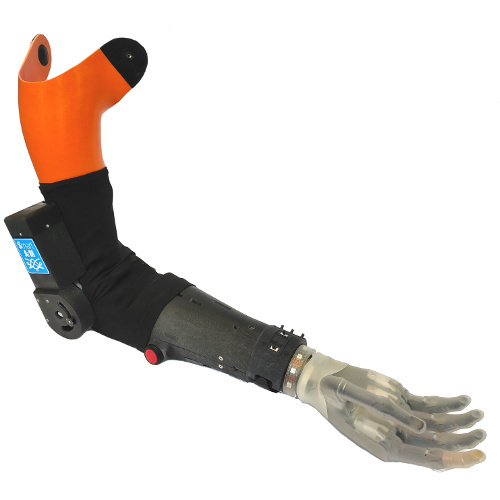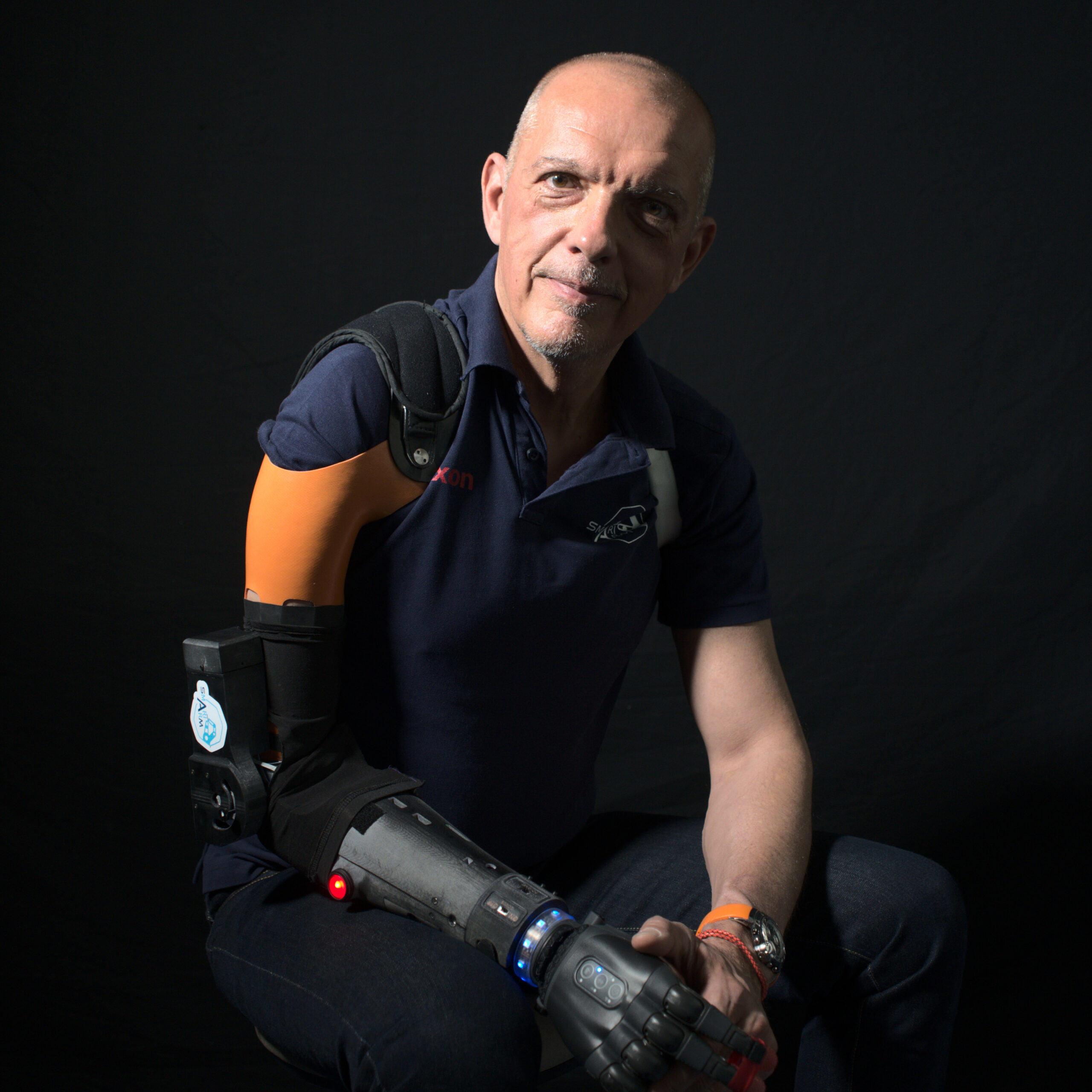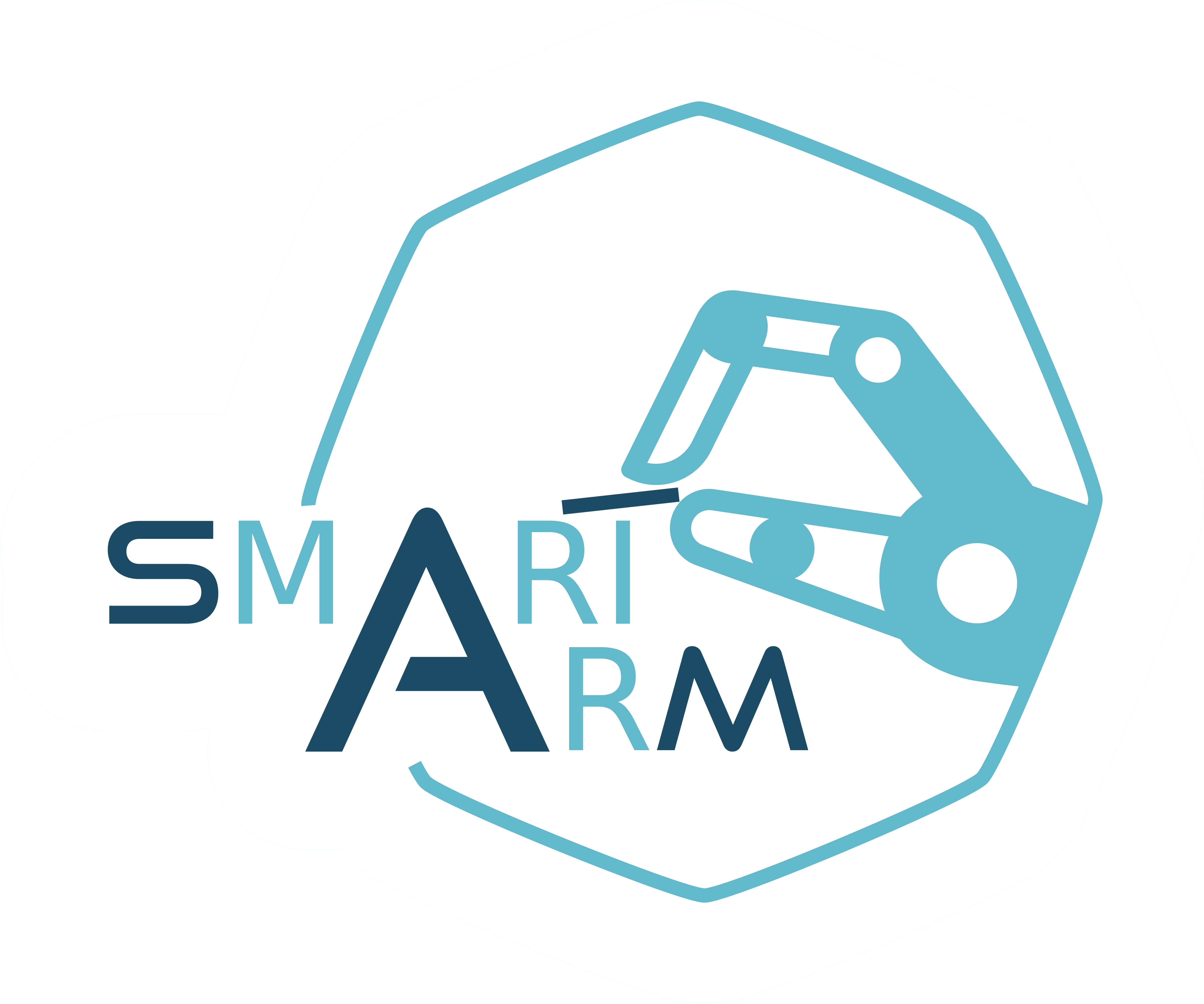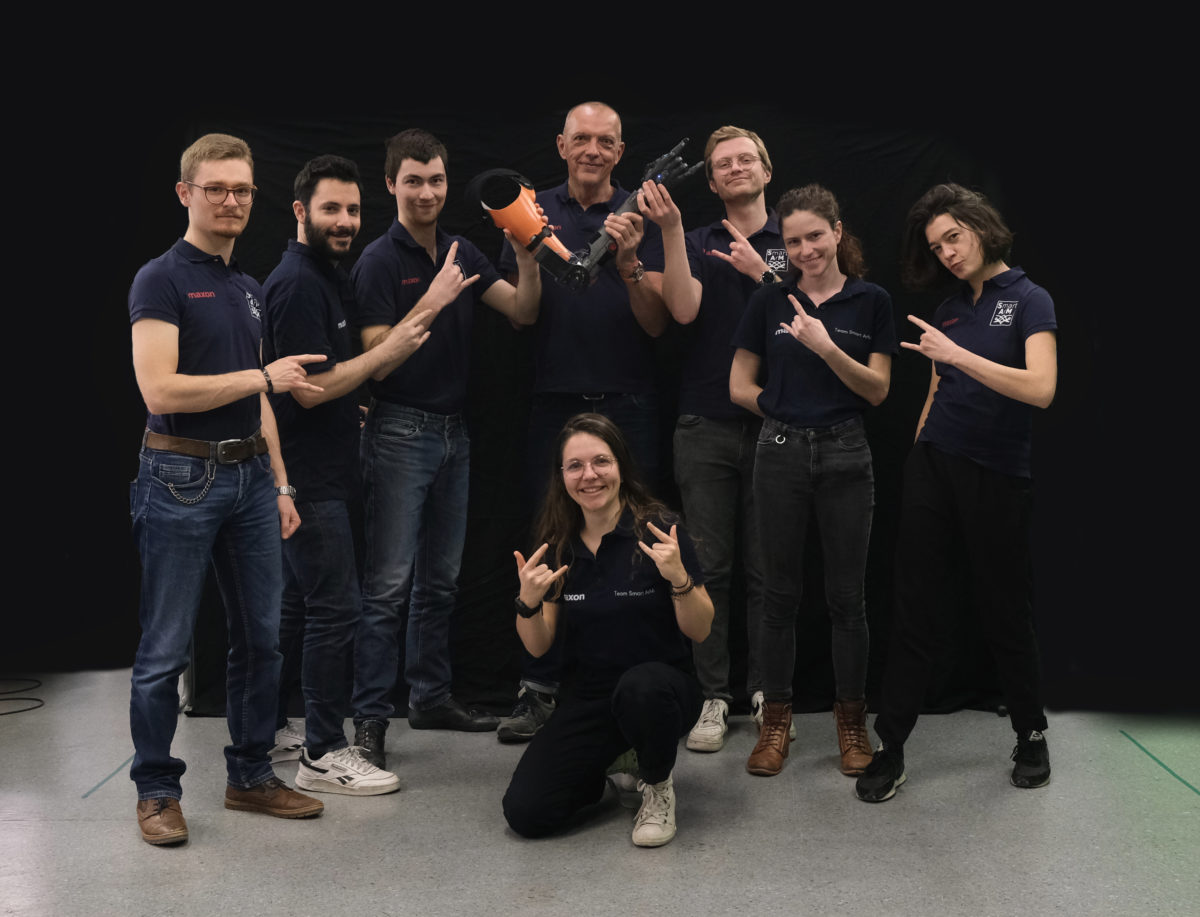What is SAM ?
SAM (shorthand for SmartArM) is a project aiming at designing arm prostheses suitable for persons with transhumeral disability i.e. who lack an elbow and forearm. The prototypes developed within this project offer intuitive and efficient control approaches to their wearers, in order to extend their motor abilities and increase their autonomy when performing Activities of Daily Living (ADL).
The goal of SAM is to draw attention on the specific case of “above-elbow” disabilities and their particularities. Indeed, prosthesis users with such disabilities have to deal with the complex control of at least two active joints (elbow and wrist) in addition to controlling the hand. As it stands, little research is conducted on the challenges related to the control of these multiple joints by a transhumeral prosthesis user. SAM also wants to promote the possibilities offered by non-invasive approaches, in reaction to the recent trends in invasive and surgical techniques (implantable electrodes, muscle reinnervation etc.).
The SAM device that is used by our team for CYBATHLON is a recent prototype designed specially for our pilot, Christophe Huchet. Christophe bears a congenital right-arm disability: he was born without a forearm but with a complete humerus. This means that his residual limb is longer than the stump of a person who underwent traumatic transhumeral amputation. These anatomical characteristics required the use of an exoskeletal elbow prosthesis, in order for the rotation axis to be congruent with that of his valid left arm.
This SAM prototype includes two motor-powered degrees of freedom: an active wrist rotator, and an exoskeletal active elbow whose original design is suitable for persons with arm agenesia. Moreover, the prosthesis can be fitted with any commercially available prosthetic hand, thanks to its wrist connector compatible with the market’s standards (Quick Disconnect Wrist). Currently, it is fitted with a prosthetic hand manufactured by our sponsor TASKA. SAM also comprises a conventional socket (fitted with 6 surface myo-electrodes) custom-made by our partner IRR-UGECAM for Christophe.


Main innovations and features
The main innovation in SAM not only lies in the hardware but also on the embedded control architecture and associated sensori-motor control schemes that we have been working on for several years. Our innovative control strategy relies on two different control modes:
– A control based on the decoding of EMG patterns generated by voluntary contractions of residual muscles in the stump, and measured with surface myo-electrodes placed inside the prosthesis socket.
– A control based on the user’s body and residual limb movements, measured with wearable inertial measurement units (IMUs) embedded in the prosthesis. This control mode essentially relies on body compensatory strategies (see below) as a source of command signals. These measurements are used to coordinate the prosthesis’s intermediate joints with the wearer’s body motion, in order to achieve faster reactions and more biomimetic gestures.
These control modes can be coupled together (each mode controlling a different subset of joints) to enhance the wearer’s dexterity.
What is “Compensation-based control”?
The SAM prototype used during CYBATHLON is the first prosthetic device to rely on this novel patented control approach which was recently developed at ISIR and aims at offering an alternative to myoelectric control.
Indeed, one major problem of conventional myoelectric control is that it is not natural. It typically involves muscles being contracted individually one after another, to control sequentially the prosthetic joints. This is far from being similar to the motion control of an able-bodied person, even more so for people with transhumeral disability. Indeed, myoelectric control requires them to use muscles (typically biceps and triceps) that are not naturally associated with the prosthetic joints they command, such as wrist prono-supination. Movement-based approaches aim at avoiding this limitation while proposing a more intuitive and easier-to-learn control.
In addition to synergy-based approaches (using learned models of coordination between joints), we have been recently developing a novel control approach that relies on body compensations instead of muscle contractions. Body compensations are movements exhibited when the mobility of one or several joints is reduced. For example, trunk or shoulder motion naturally happens when it is hard to move the elbow and/or the wrist, whether it is because of an unresponsive limb prosthesis, a limb paralyzed after a stroke or a simple sprain affecting our motor behavior.
These compensatory movements are good indicators of the adequacy of the prosthesis’s position with the wearer’s intention. Indeed, if the elbow is not flexed/extended enough or if the hand is not well oriented, the prosthesis wearer will typically attempt to correct this with body compensations, e.g. bending down, flexing the trunk to one side. Our compensation-based control measures in real time these movements, then computes the prosthesis movement required to make the wearer go back to a more comfortable position, while keeping the hand well positioned or well oriented.
This results in prosthesis actions being perfectly coordinated with the wearer’s body movements, without requiring the wearer to send specific commands to the prosthesis or having to learn complex control strategies. In short: the prosthesis basically decodes the natural body kinematic language of its user!
The SmartArM-W technology
Taking advantage of the lessons learned while developing our SAM prosthesis for the ARM race, our team is now applying the principles of compensation-based control on an assistive robotic arm for the ROB race. The technology employed by our pilot in this category is dubbed “SmartArM-W”, where the name of the team followed by the initial of the word “Wheelchair”.
In order to compete in the ROB category, we develop with our pilot Étienne Moullet, a person with tetraplegia, an apparatus made of a seven-joint robotic arm, equipped with a two-prong pincer acting as end-effector. This robotic device is mounted on a wheeled platform, itself fixed to the right side of the pilot’s wheelchair, at knee level. In order to control this robot, the pilot can use several ways to drive the pincer’s position along the three dimensions of space:
- With his hands, through a tactile screen and a sensor detecting his hand motion
- With a HoloLens headset detecting his head motion
These control schemes stem from our recent works on the control of a supernumerary robotic arm, as illustrated in this video:
In a broader sense, this apparatus is designed as an experimental platform on which to test innovations that help meet the needs of persons in wheelchair with limited arm mobility. In particular, it allows researchers in our team to develop strategies to control such a robotic arm in the most versatile and intuitive way possible.
More information on our technology and expertise can be found in the following recent works from our team:
– Merad, M., de Montalivet, E., Legrand, M., Mastinu, E., Ortiz-Catalan, M., Touillet, A., … & Jarrassé, N. (2020). Assessment of an automatic prosthetic elbow control strategy using residual limb motion for transhumeral amputated individuals with socket or osseointegrated prostheses. IEEE Transactions on Medical Robotics and Bionics. PDF
– Legrand, M., de Montalivet, E., Richer, F., Jarrasse, N., & Morel, G. (2019, June). Reciprocal Kinematic Control: using human-robot dual adaptation to control upper limb assistive devices. PDF
– Legrand, M., Jarrassé, N. Richer, F. Morel, G. (2020, May) A closed-loop and ergonomic control for prosthetic wrist rotation. IEEE. Proc. International Conference on Robotics and Automation (ICRA)
– Jarrassé, N., De Montalivet, É., Richer, F., Nicol, C., Touillet, A., Martinet, N., … & De Graaf, J. B. (2018). Phantom-mobility-based prosthesis control in transhumeral amputees without surgical reinnervation: A preliminary study. Frontiers in bioengineering and biotechnology, 6, 164. PDF
– Jarrassé, N., Nicol, C., Touillet, A., Richer, F., Martinet, N., Paysant, J., & de Graaf, J. B. (2016). Classification of phantom finger, hand, wrist, and elbow voluntary gestures in transhumeral amputees with sEMG. IEEE Transactions on Neural Systems and Rehabilitation Engineering, 25(1), 71-80. PDF

